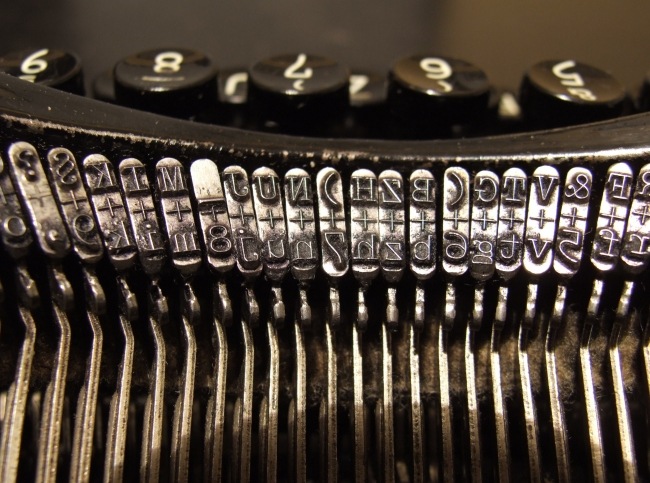Transcription and Typing

First Typewriter – Transcription and Typing
 Transcription and Typing – The first typewriter recognised as being “commercially successful” is one invented in 1868 by Christopher Latham Sholes, Carlos Glidden and Samuel W. Soule in Milwaukee, Wisconsin. [1]
Transcription and Typing – The first typewriter recognised as being “commercially successful” is one invented in 1868 by Christopher Latham Sholes, Carlos Glidden and Samuel W. Soule in Milwaukee, Wisconsin. [1]
The patent was sold for $12,000 to a company called Densmore and Yost, who tried to manufacture the machine. The company made an agreement with E. Remington and Sons to produce the machine. In 1874, the Sholes and Glidden Type-Writer went on sale.
It had a QWERTY keyboard, and was a blind writer, as the keys struck upwards. It meant that the typist couldn’t see the characters as they were being typed. [2]
Learning to Type
 Children these days learn the keyboard very quickly without ever having a typing lesson. Because they navigate the keyboard using one hand or just two fingers, does that make it wrong because they are not using the tried and tested methods?
Children these days learn the keyboard very quickly without ever having a typing lesson. Because they navigate the keyboard using one hand or just two fingers, does that make it wrong because they are not using the tried and tested methods?
Learning to type, in the traditional way, is about learning which fingers type which letters, lots of repetition, and then the development of typing by touch or touch typing, by muscle memory. It was believed that this was the most efficient way of typing. Once the individual has mastered touch typing, the development of speed is crucial.
Children today can learn to type by games that teach them whilst having fun. It becomes second nature very quickly as they are using mobile devices with keyboards from a very young age.
Typing speeds used to be the benchmark, along with accuracy, for administrative jobs. The job adverts used to state how many words per minute the individual needed to be able to type in order to be considered for the job. A typing test, at interview, was standard to check speed. Check your typing speed here.
Here are some best practice pointers for safe and efficient typing. You can view the web page here for full details.
Posture – sit straight, elbows at right angles, face the screen with head tilted slightly forward
Home keys – ensure you always return your fingers to the home keys between typing bouts
Take a break – ensure you take regular breaks, to rest your eyes and your hands, wrists and shoulders
Evolution of the Typewriter
Since the invention of the typewriter, the keyboard, as it has become known, has evolved hugely.

The concept of the modern keyboard has also changed, with the invention of mobile technology.

Typing Then and Now
When I learned to type, it was on the old fashioned manual keyboards, in a cold hut, whilst at sixth form college. Having mastered the basics, I then progressed to an electronic word processor that took on another learning journey. The keyboard was more reactive and faster, the keys required less pressure and what had been manual calculations before for tabs or centring were now a more automated process.
 Typewriters and word processors gave way to computers, with small screens, small memory capacity and large keyboards. As technology progressed, screens got larger and so did the memory, and keyboards became more streamlined.
Typewriters and word processors gave way to computers, with small screens, small memory capacity and large keyboards. As technology progressed, screens got larger and so did the memory, and keyboards became more streamlined.
Eventually, the computers got smaller in physical size, massive in capacity and screen and keyboard condensed into one device. Typing can still be done manually on touchscreen with fingers or a stylus. But you can now dictate to your device and it is clever enough to recognise what it is you want to say.
The documentation produced has also changed. Letters used to be the only way to communicate, and these were typewritten or handwritten. Emails became another way to stay in touch, followed by text messaging.
 Social media followed, allowing words to reach their recipient in a flash.
Social media followed, allowing words to reach their recipient in a flash.
Technology exists to allow a user with a disability to type by having their eye movements tracked on a keyboard… Stephen Hawking.
The future is here – you can now buy a virtual keyboard, which a small bluetooth device projects on to a flat surface, offering the user a full keyboard experience. [3]

Whatever next?
Transcription and Typing
Whatever you need typing, Fingertips Typing Services can help. We have years of experience of typing and transcribing a variety of projects, for example, but not limited to:
- Interviews/focus groups/seminar/conferences
- Medical reports
- Property/lettings/estate agents reports
- Legal/insurance reports
- Education/dissertation/theses
Visit the Fingertips Typing website to see how we can help you work effectively, by providing a friendly, professional and personal service.
Written by: Debbie Rowe, typist for Fingertips Typing Services
Resources
[1] https://en.wikipedia.org/wiki/Typewriter
[2] https://en.wikipedia.org/wiki/Sholes_and_Glidden_typewriter
[3] http://gandtnews4u.blogspot.com/2012/12/cube-laser-virtual-keyboard-future-of_75.html
